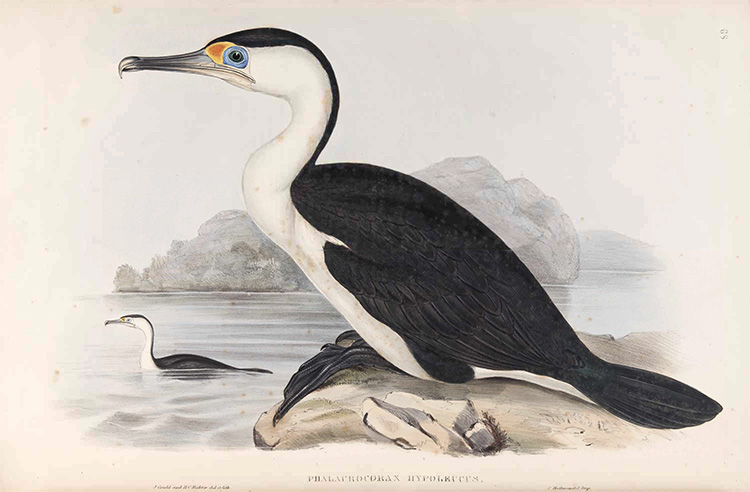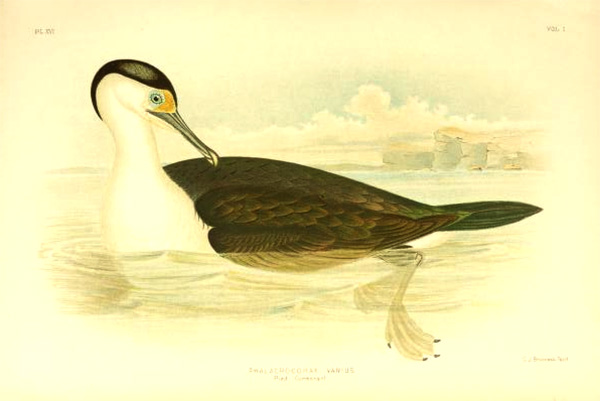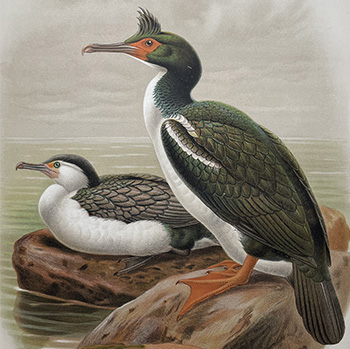


Pied cormorant, John Gould, Birds of Australia, 1840-48.
Of the world's 36 species of shag 12 are found in New Zealand and 8 of these are endemic. Members of the shag family belong to three groups based on the colour of their feet: black, yellow or pink. The Pied shag is black-footed. In New Zealand, all members of the Phalacrocoracidae are called shags. The term shag seems to have come about in reference to the crest on the head of some species.
Outside New Zealand, the black-footed shags are better known as cormorants. According to Schuckard, the names "cormorant" and "shag" were originally the common names of the two species of the family found in Great Britain, the Great Cormorant, Phalacrocorax carbo and the European Shag, P. aristotelis. "Shag" refers to the bird's crest, which the British forms of the Great Cormorant lack but the same species is called the Black Shag in New Zealand where it has a small crest on upper nape and neck. Despite this confusion, taxonomists still propose to divide the family into two genera with the name "Cormorant" and "Shag". The proposed division into subfamily Phalacrocoracinae "cormorants" and Leucocarboninae "shags" does indeed have some degree of merit although the entire family cannot be clearly divided at present beyond the super species or species-complex level. Several evolutionary groups are still recognizable, but a great deal of convergent evolution, such as cliff shags, is complicating matters. The resolution provided by the mtDNA is not sufficient to properly resolve several groups to satisfaction. In addition, many species remain unsampled for DNA, the fossil record has not been integrated in the data, and the effects of hybridization, known in some Pacific species, on the DNA sequence data, are unstudied.
The pied shag is found exclusively in Australia and New Zealand, wintering along the whole coast and inland in both countries. It was first described from New Zealand by Latham, who used the specimens collected at Queen Charlotte Sound by Forster during Captain James Cook’s second voyage.
This species is mainly marine, but occupies a variety of water bodies both offshore, on the coast and inland. Fish comprise roughly 90% of its diet, but it will also feed on crustaceans, and a few molluscs and cephalopods. It feeds exclusively by pursuit-diving and often forms feeding flocks at sea.
Its breeding season varies considerably with region and year depending on local conditions, generally forming colonies in a variety of habitats, coastal islands, flooded tree plains, mangroves and sometimes on artificial structures such as beacons. The large nest is constructed from seaweed, twigs or sticks cemented together with droppings, and is placed in a tree or on the ground. Both parents build the nest, incubate the eggs and feed the young. Adults are basically sedentary, with juveniles dispersing widely.
It is probably the pied shag that Sir Joseph Banks refers to in the following paragraph, the locality and date being, Mercury bay, 10th November, 1769; “The water was shoal so we agreed to stop our disquisition here and go ashore and dine. A tree in the neighborhood on which were many shag’s nests and old shags sitting by them confirmed our resolution. An attack was consequently made on the shags and about twenty were soon killed, and so soon broiled and eaten, everyone declaring that they were excellent food, as indeed I think they were.”


Pied cormorant from G.J. Broinowski's The Birds of Australia, 1887-1891.
| Taxonomy | |
|---|---|
| Kingdom: | Animalia |
| Phylum: | Chordata |
| Class: | Aves |
| Order: | Pelecaniformes |
| Family: | Phalacrocoracidae |
| Genera: | Phalacrocorax |
| Species: | varius |
| Sub Species: | varius, hypoleucos (Australia) |
Pied cormorant, yellow-faced cormorant.
Native bird
81 cm., 2 kg., black above, face from above eye and all underparts white except for black thighs, long grey bill, eye-ring blue, feet black.
Widespread, especially in the Bay of Islands, Hauraki Gulf, Coromandel and Marlborough.
Poetry: —
The War of the Birds
Said the Shag of the green river to the Shag of the grey sea:
“Come now into the swamplands and eat my food with me.
The sea is cold and salty; it gives with grudging hand,
But sweet the fare and meet the fare that stirs up on the land.”
Then the Shag of the green river led the Shag of the grey sea
Where the toi-tois plume their heads, and eels slip lazily.
The sea-bird dived and caught an eel and ate with clucking note.
“Now bring it back,” the land-bird said. It glided up its throat.
The sea-Shag then was angry, as angry as could be.
He vowed a vengeance on the bird that mocked the shining sea.
He led him to the ocean and bade him dive therein.
The land-Shag, swooping, saw below a sharp and shining fin.
The sea-Shag watched him eat it, nodding a slow old head,
“And now, my doughty land-bird, just bring that back,” he said.
“Oh, easy!” said the boaster - in innocence he lied,
Its bitter fin-points pierced him, he gave one cry, and died.
And all his angry kinsfolk came wailing up the sky;
The air was black with pinions - a gale of birds flew by.
They fell upon the sea-birds, and battle was begun;
They darkened land and ocean; they blotted out the sun.
They died upon the water, they died upon the sand;
But others came in hosting from ocean and from land.
And who were there the victors there is not one that knows,
Except the secret waters, and the wise wind that blows.
But still at nights they tell it, in hushed and solemn words -
Wing fighting wing in tumult - the battle of the birds.
— Eileen Duggan

Kāruhiruhi, Pied shag and Chatham shag from Buller's The Birds of New Zealand, 1888.
Gould, John, Birds of Australia, 1840-48.
G.J. Broinowski The Birds of Australia, 1887-1891.
Buller, Walter Lawry, Birds of New Zealand, 1888.
Heather, B., & Robertson, H., Field Guide to the Birds of New Zealand,2000.
Oliver, W.R.B. New Zealand Birds, 1955.
Rob Schuckard, OSNZ.
Sunday, 5 November, 2023; ver2023